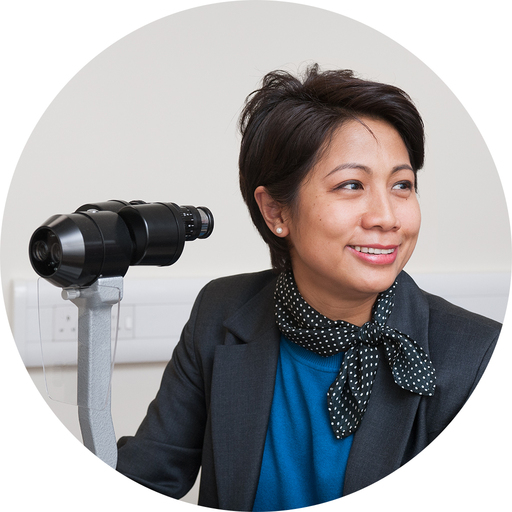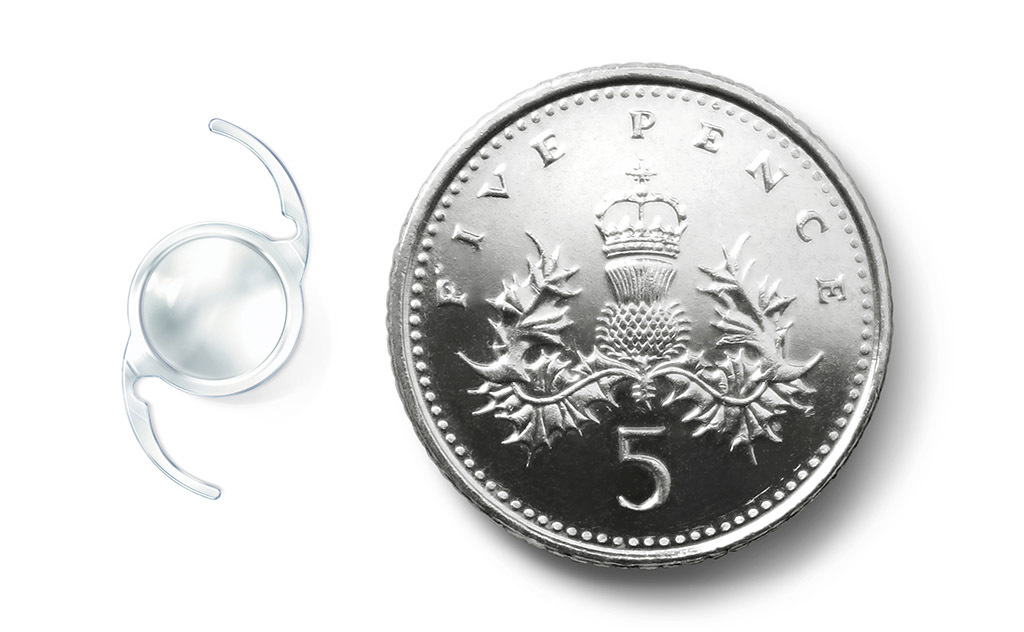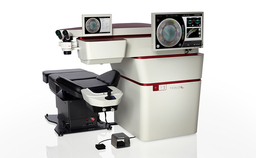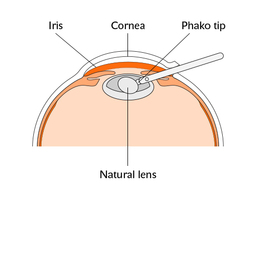
Refractive Lens Exchange
- Femtosecond laser refractive lens surgery
Many people choose refractive lens surgery to reduce or eliminate total dependence on glasses or contact lenses when laser eye surgery is not suitable. As a specialist refractive lens and cataract surgeon, Mr Stevens has been successfully implanting lenses for more than 20 years. He is highly regarded for his role in the development of the latest technique known as “femto-phako”.
What is refractive lens surgery?
Refractive lens surgery (also known as lens surgery, refractive lens exchange, clear lens surgery or refractive lens replacement) is where the natural lens of the eye is removed and replaced with a modern intraocular lens implant (IOL). The same technique is also used to treat cataract.
Why consider lens surgery?

Lens surgery is an attractive alternative for those who want to reduce or eliminate total dependence on glasses or contact lenses, where laser eye surgery is not suitable or advisable. For many people lens surgery is also an opportunity to correct or reduce pre-existing astigmatism.
Common groups seeking lens surgery include:
- Those with very large prescriptions (refractive errors).
- Those who are older where dry eye is an issue.
- Those of an age where lens changes (cataract) are likely to develop in the near future or where there are already some lens changes.
- Those who wish to reduce dependency on reading glasses.
Why choose Julian Stevens?
Julian Stevens has an excellent reputation for clinical knowledge, expertise and results. He performs small-incision surgery using the most advanced technique known as femtosecond laser lens surgery (femto-phako).
Clinical excellence
Having successfully implanted lenses for more than 20 years, Julian Stevens is highly skilled and experienced. He has performed over 6,000 lens implant procedures.
During your initial consultation, Mr Stevens will advise you about your eyes, personalised treatment options and suitability.
Astigmatism correction or reduction is offered by Mr Stevens.
The lens implant is carefully chosen and calculated by Mr Stevens specifically for you. Premium aspheric lens implants (including advanced multifocals) are offered if appropriate.
A specialist and highly knowledgeable team work closely with Mr Stevens, offering you the best possible service and care.
Reputation
Julian Stevens is a key contributor to the development of femtosecond laser lens surgery and he uses the state-of-the-art Catalys system. He is internationally recognised for his commitment to using the most advanced technology available.
Mr Stevens’ reputation attracts many medical practitioners for their own treatment, including GPs, Consultants and Optometrists. He has a proven track record of achieving excellent results.
Julian Stevens has an exceptional academic background, graduating from Oxford, and then undertaking further clinical training at Cambridge, and higher specialist training at Moorfields.
Trust
Mr Stevens performs his treatments at Centre for Sight London. This specialist ophthlmic
environment offers you the highest level of safety and peace of mind.Julian Stevens audits his results and has a reassuring track record for achieving a very low complication rate for lens surgery.
Higher surgical specialist training and continual review ensure the highest level of clinical expertise.
Reading vision and presbyopia
Presbyopia is the normal ageing of the lens inside the eye. It reduces the eye’s ability to change focus. As we reach middle age, near vision is affected and reading glasses are often required. Lens surgery can be an attractive option for those in middle age who want both distance and near vision, reducing the need for reading glasses.
Femtosecond laser refractive lens surgery (femto-phako)
Traditional refractive lens surgery is known as phakoemulsification (phako) or small-incision surgery. The most advanced small-incision lens procedure is laser lens surgery, where a femtosecond laser is used to complete some of the steps previously performed by the surgeon. This technique has great precision and is often referred to as “femto-phako”.
Advantages of femtosecond laser lens surgery:
- The Catalys femtosecond laser has great precision and is potentially more consistent than a human surgeon performing the same steps manually.
- The procedure is quick and efficient.
- Normally immediate return of vision after surgery.
- Usually no stitch required.
- Performing some of the steps with the femtosecond laser normally results in less or no ultrasound energy used.
- Up to a certain level of astigmatism can be treated or reduced by the laser at the time of surgery.
The femto-phako procedure
Femto-phako treatment normally involves a fast recovery of vision and a lack of pain or discomfort. Each treatment is customised to the individual eye and aims to provide high quality of vision after surgery. The Catalys femtosecond laser system is used during the first stage of the procedure to complete some of the steps previously performed using hand-held instruments.
Anaesthesia
This is either local or occasionally general anaesthesia. Most choose local anaesthesia because there is no needle injection and sedation can be administered to relax you during the procedure.
Treatment time
The laser part of the procedure takes about three minutes. This is followed by about 8 - 15 minutes in the main operating theatre to complete the procedure.
Stage 1
The laser gently creates a circular opening in the lens of the eye, and the natural lens is then softened and fragmented by the laser. Astigmatism is then treated by the laser changing the shape of the cornea at the front of the eye. Then a small self-sealing incision (1.8 to 2.7mm wide) is made in the cornea using the laser or a purpose designed micro-surgical instrument.
Stage 2
The latest AMO Signature machine is used to remove the natural lens fragments.
Stage 3
The capsule that holds the natural lens is carefully preserved during surgery.
Stage 4
A modern folding lens implant is inserted. This is usually folded inside an injector device, to enable it to pass through the small incision.
The lens implant

The intraocular lens implant used to replace the natural human lens during surgery is designed to allow very sharp vision, if all other circumstances allow this. Julian Stevens uses only the best and most advanced lenses available, aiming to deliver the highest quality vision. The lens implant is expected to last a lifetime.
Monofocal lenses
A monofocal lens aims to give clear vision at a single focus. This means that if the lens implant is set for clear distance vision then reading glasses will normally be required. Usually the lens implant is chosen to aim for clear distance vision or set at a different focus in each eye (blended vision or monovision). Monovision works well if the recipient is already used to this with previous contact lens wearing.
Multifocal lenses
These are lens implants with focus for both distance and middle, as well as for some near vision. They have the potential to significantly reduce dependence on reading glasses and are very popular. However, multifocal lenses involve some compromise with certain optical effects such as a mild glow or halo around lights and there can be glare with bright lights. There can also be some reduction in the contrast of vision. Many people tolerate this to gain the benefit of having distance, middle and some near unaided vision.
Aspheric lenses
State-of-the-art aspheric lenses are designed to optimise vision and may improve optical quality in low contrast conditions or when driving at night. These premium lenses provide a sharper focus of vision for some people and can be monofocal or multifocal.
Technology
Mr Stevens and his team use advanced technology designed for the best clinical outcome and for your safety and reassurance.
Optical biometry
Biometry is the measurement of the eye to assess the lens implant strength required. The curvature of the cornea at the front of the eye and the length of the eye are assessed before surgery. This is performed by OCT optical biometry, which results in more precise lens implantation calculations.
Advanced biometry calculations
Biometry scanning is combined with the latest generation of calculation software for the most precise outcomes. This includes one of the latest advanced formulae (BESSt formula), which is used in special circumstances by surgeons around the world. This was developed by Julian Stevens together with Dr Edmondo Borassio and Mr Guy Smith.
Corneal topography
All patients prior to surgery have the shape of the cornea and astigmatism measured at the front of the eye; this is called corneal topography assessment. This scan is used when choosing the type of lens implant.
Phakoemulsification
The latest AMO Signature phakoemulsification machine is used for the procedure, with advanced fluidics and pressure control. It uses minimal energy with shaped micropulse ultrasound to remove the natural lens.
Femtosecond laser technology
A femtosecond laser is an ultrafast pulsed laser, which has great precision. Mr Stevens and his team use the Catalys femtosecond laser system from Optimedica to perform the first stage of the procedure.
Advanced 3D imaging
Like a fingerprint, every eye has a unique size and shape. Prior to treatment, the Catalys femtosecond laser system images your eye and makes precise 3D maps of relevant structures. This provides a customised treatment plan for each eye.
Laser precision
Catalys helps the surgeon to create a perfectly sized, shaped and centered circular opening to access and remove the natural lens. This precision helps Mr Stevens place the new artificial lens exactly where intended. Correct positioning of the chosen lens implant is very important as this will affect the result.
Gentle approach
The laser can be used to soften and disassemble the natural lens prior to removal. Softening the lens with the Catalys enables Mr Stevens to remove the natural lens more gently and with significantly less ultrasound energy than is used in traditional manual lens surgery.
Astigmatism
The laser can also be focused into the cornea at the front of the eye, aiming to reduce pre-existing astigmatism.
What affects the outcome?
The skill and expertise of the surgeon is the biggest factor in the outcome of your treatment. Mr Stevens monitors the quality of vision achieved and audits his results. Learn more about Julian Stevens.
The outcome of refractive lens surgery is also dependent upon:
- The accuracy of measurements and calculations for the lens implant power (biometry).
- The type of lens implant used.
- Femtosecond laser lens surgery.
- The technology and phako equipment.
- The co-operation of the patient during the procedure.
- The natural healing process of the eye itself.
- The presence of other ocular conditions affecting the prognosis after lens surgery.
Your refractive lens consultation

Your consultation is a thorough assessment of your vision and your visual needs and normally lasts two hours. When you meet with Mr Stevens you will be advised about your eyes. If treatment is planned, Mr Stevens will recommend suitable lenses based on your individual requirements.
What to expect
Your initial consultation involves an assessment of your vision and a full eye examination. You will have a detailed sight test, advanced biometry measurements, corneal topography and pressure checks. Dilating drops may be used, which might blur vision for a number of hours.
Mr Stevens' team
Mr Stevens’ Specialist Optometrist and Ophthalmic Technician will take measurements during your consultation. These involve high skill and accuracy and provide Mr Stevens with the detailed information he needs to discuss treatment options with you. The lens implant type and power is very carefully calculated prior to treatment.
Personalised treatment discussion with Mr Stevens
As well as reviewing your eyes and assessing all the objective scans and measurements, Mr Stevens will discuss a detailed assessment of your individual visual requirements. This takes into account your age, occupation, lifestyle and expectations. You will have the opportunity to discuss any concerns and ask any questions. Refractive lens surgery is an elective procedure.
Your treatment and aftercare
If you would like more information about what happens on the day of surgery and what to expect in the days, weeks and months that follow, please refer to our Refractive Lens Surgery information booklet, available at the bottom of the page. If you plan to stay in London overnight, we can recommend [hotels and restaurants near Regents Park / Queen Anne Street W1.]
YAG laser treatment
Months or years after lens surgery approximately 50% of people have a laser treatment to clear a cloudy lens capsule, which is causing blurred vision. This is a separate procedure called YAG capsulotomy and is performed by Mr Stevens. YAG capsulotomy is very quick, highly effective and does not normally need to be repeated.
Please be advised that if YAG laser treatment is required, this is not included in the lens procedure fee. The fees for YAG assessment and treatment can be found on our prices page.
Possible complications
Mr Stevens has an excellent track record for achieving a very low complication rate for lens surgery. However all surgery carries some risk.
Serious complications permanently affecting vision are rare and are lowest with a specialist experienced lens surgeon. Lesser complications (that are treatable or which resolve over time) occur at about 1% using the latest equipment. About 0.1% (1 in 1000) may lose some degree of vision as a result of a complication attributed to surgery.
For most people the quality of vision achieved after surgery is positively life changing. However all lens surgery has some degree of unpredictability.
Please refer to our Refractive Lens Surgery information booklet for more detailed information. You should read all the information given to you about possible complications before undergoing any treatment.
Frequently asked questions

Is refractive lens surgery safe?
When performed by a skilled specialist refractive lens surgeon with modern equipment, lens implant surgery has a low risk of serious complication (1 in 1000).
Is refractive lens surgery the same as laser vision correction?
No. Unlike laser eye surgery which treats the cornea at the front of the eye, refractive lens surgery removes the natural lens and implants an intraocular lens (IOL). A femtosecond laser is used during the first stage of the procedure.
How good will my vision be following refractive lens surgery?
The aim of treatment is to provide high quality vision, but the range of focus is not complete. As such, commonly weak reading glasses are required for best near focus. There may be some glare, haloes and ghosting with multifocal lenses.
About the procedure
Does the procedure hurt?
There is no pain during the procedure, although there may be a feeling of pressure.
How does femto-phako differ from traditional lens surgery?
Femto-phako is where an ultrafast pulsed femtosecond laser is used to complete some of the steps previously performed by the surgeon using handheld instruments. The femto-phako technique has great precision.
Can I have both eyes treated at the same time?
Internationally many surgeons operate on both eyes in one treatment session, or surgery can be performed to one eye at a time. Mr Stevens will give individual advice.
How long does the treatment take?
It is not a race; treatment takes as long as necessary. Normally you will be in the theatre suite for a total of 8 – 15 minutes.
Will I need to be in London overnight?
There is usually no need for a check-up the next day, so it is not necessary to be in London overnight. However if you do choose to stay in London we can recommend [hotels and restaurants near Regents Park / Queen Anne Street W1. For those who are having both eyes treated on the same day it is common to have a check-up the next day.
About after treatment
How quickly will I see after surgery?
Normally the vision is soft focus immediately after surgery and the next day vision is often good.
When can I drive?
Mr Stevens will advise depending upon your individual circumstances, with most people driving again only after both eyes have been treated. When only one eye is being treated driving usually commences a few days after surgery.
When can I work?
This depends upon your occupation. Most people with office-based occupations resume work within a few days or a week. Those who work in a dusty environment may need two to four weeks off work.
Are activities restricted after surgery?
Common sense needs to be applied but people can bend over, wash, shop and carry out general activities. On the day following surgery you can take a bath or shower and use a computer. Sports can be resumed after a few weeks or a month. Flying as a passenger can be done the day after surgery but as a pilot the necessary licensing needs to be completed before flying resumes.
Will I still need to wear glasses?
Many people do not need to wear distance glasses after modern lens surgery, but this is not guaranteed. If there is clear distance vision, reading glasses are normally required unless there is a multifocal lens implant or monovision. For those with a multifocal implant or monovision, glasses may still be required for some tasks.
About the long term
Is refractive lens surgery permanent?
The lens implant is expected to last a lifetime so vision normally remains the same unless there is another medical condition with the eye. The only “maintenance” is the possible need for a YAG laser procedure to clear a cloudy lens capsule.
Will I need to go back to my optician after surgery?
After you have completed your follow-up appointment(s) with Julian Stevens you should return to the care of your local optician for long-term sight testing and regular review of your eyes.

